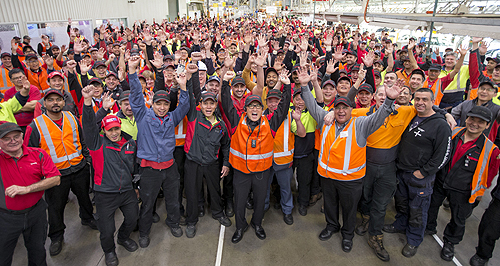Make / Model Search
News - ToyotaToyota exit: TMC boss farewells Aussie plantLast goodbye: Toyota Motor Corporation president Akio Toyoda (centre) visited the Altona factory in August to thank and farewell local employees. Akio Toyoda expresses emotional thankyou to 2600 Toyota workers as Altona closes4 Oct 2017 TOYOTA Motor Corporation (TMC) president Akio Toyoda paid a personal visit to Melbourne in late August to say goodbye to many of the 2600 Toyota workers facing redundancy when the Altona factory ceased production yesterday, bringing the curtain down on 54 years of Australian manufacturing that generated 3.4 million Toyota cars. The grandson of TMC founder Kiichiro Toyoda solemnly walked the floor of the giant facility to shake hands with assembly line workers and express his appreciation for their service in what was described by Toyota Australia chairman Max Yasuda as an emotional day. He also addressed the final assembly of workers and invited guests yesterday (approximately 3000 in total) via video at the factory closure ceremony, expressing his sorrow at the shutdown – the first of any Toyota plant of significance anywhere in the world. The closure has been taken personally by senior Toyota executives who, once the decision was announced in February 2014 to shutter the factory, ordered an investigation into the Australian manufacturing collapse and how lessons could be applied elsewhere to prevent a repeat. Toyota’s Australian factory shutdown was triggered by falling sales of medium and large passenger cars built at the plant for local and export markets, along with Holden’s earlier decision to close manufacturing which skittled many of their mutual suppliers. The Holden plant at Elizabeth in South Australia will be the last Australian car mass-production plant to go, on October 20. The other of the “big three” Australian car-makers, Ford, shut its two factories in Victoria a year ago. Operations at Altona in Melbourne’s west have been progressively closed over the past few weeks, starting with areas producing components and finishing with general assembly – the main production line where cars are completed. Exports – mainly to the Middle East at the rate of 30,000 a year recently – finished about two weeks ago. Among the last vehicles coming off the line were 54 commemorative Camrys – one for each year of Toyota production in Australia. One of those cars will be kept by Toyota Australia for a heritage centre at its Altona site which it plans to retain for various purposes including a parts warehouse, training centre and car test track. Another of the Camrys will go to the Australian National Museum in Canberra, while the final 52 will be distributed to dealers for sale. From today, Toyota Australia becomes a sales and marketing outfit with some design and engineering operations on the side. It will import all its vehicles, including an all-new Japanese-built Camry from November. Toyota’s Australian operation is being consolidated at its head office in Port Melbourne near where independent car-maker Australian Motor Industries (AMI) built the first Australian Toyota – a Tiara – in 1963. In a press conference held by senior Australian Toyota executives with motoring journalists under embargo last week, Mr Yasuda said Mr Toyoda had timed his personal visit to the plant to ensure he got to thank as many of the workers as possible before areas began closing. The visit came around the time the factory was building its last batch of V6 Aurion large cars. “He wanted to meet with the people while the factory was still running,” Mr Yasuda said. “He went around the factory, talking with people and expressing his appreciation. That itself was quite an emotional day.” Mr Yasuda said the factory closure had had a deep impact on Toyota which never considered withdrawing from a market: “Once Toyota is in, there is no word of pulling out.” He continued: “But this Australian closure is the first major decision (to close a factory) that TMC ever made. In that sense, this is sort of unique. “And one of the things we discussed with TMC when we made the decision, was let’s review what happened, why we have to make this kind of decision, and make sure that this would never happen into the future. “We have so many factories around the world, which are struggling, but learning from what happened in Australia, we want to make sure that it will never happen.” Unlike Holden, which has progressively shed employees since it made its announcement in late 2013 to close its factory this year, Toyota has kept them on to maintain production at the rate of 90,000 units a year to the end. Toyota Australia president Dave Buttner – a 41-year veteran of the Australian car industry, including more than 30 years with Toyota – said the company had decided to maintain production levels for a number of reasons, including parts suppliers who needed certainty. “Our local supplier base – we needed to support them,” he said. “If their volumes dived, they wouldn’t cover their costs, so they needed the volume. “We made a commitment, and had very strong support from TMC to maintain good volume for our exports at around 30,000 (units a year). “So we did not need to divest ourselves of any employees until the end.” Like a number of senior Toyota executives, Mr Buttner will pass the baton to a new generation of leaders in Australia to take the company into its import era. New president will be current vice-president Matthew Callachor, an Australian who has risen up the ranks of the Australian operation through its sales and marketing operations. From January 1, he takes charge of the newly consolidated Toyota Australia in Melbourne. This includes sales and marketing operations that, for many years, have been based in Sydney. Of the 360 employees at the Sydney office, just 80 are making the transfer to Melbourne, with the others taking redundancy.  Read more4th of October 2017  Toyota exit: More than 3.4 million cars made hereAfter 54 years, Toyota closes its factory doors with 3.4 million cars produced4th of October 2017  Toyota exit: Heavy casualties in supply chainJob losses run deep in Toyota supply chain but new doors open for parts-makers4th of October 2017  Toyota exit: Altona factory ends on a highAltona factory closes at the top of its game as Toyota details employee support4th of October 2017  Toyota exit: Engine plant headed overseasUnnamed Toyota affiliate to get Australian engine plant partly funded by taxpayers4th of October 2017  Toyota exit: 77 per cent of Sydney staff let goToyota’s sales and marketing transfer to Melbourne causes 280 job casualties4th of October 2017  Toyota exit: Market leader expects to hold sales, shareImpact on sales, brand perception unlikely to shift after factory closure: Toyota25th of August 2017  Australian-built Toyota Aurion bows outCurtains close on locally made Toyota Aurion V6 ahead of Camry finale10th of May 2017  Toyota puts Altona machinery up for saleGiant auto manufacturing equipment sale starts as Toyota shuts up shop in Oz |
Click to shareToyota articlesResearch Toyota Motor industry news |











Facebook Twitter Instagram